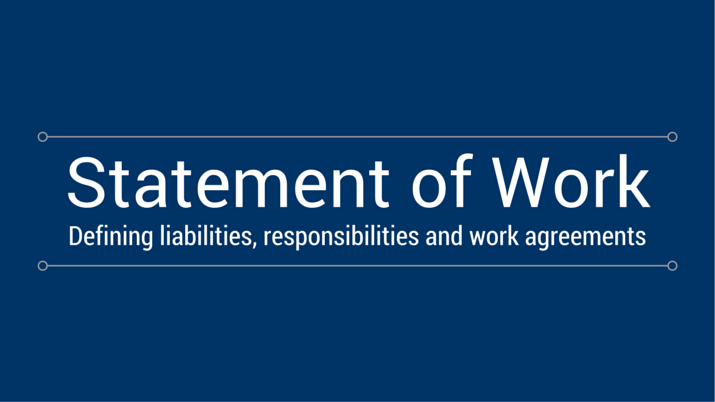What is a Statement of Work?

Last Updated January 29, 2015
A Statement of Work (SOW) is a document within a contract that describes the work requirements for a specific project along with its performance and design expectations. The main purpose of the SOW is to define the liabilities, responsibilities and work agreements between two parties, usually clients and service providers.
SOWs should be written in precise language that is relevant to the field of business. This prevents misinterpretations of terms and requirements. Although detailed, a SOW is a general description of work. Whenever further specifications of a particular task are needed, the SOW makes reference to supplementary documentation.
A well-written SOW will define the scope and Key Performance Indicators (KPIs) for the agreement. These KPIs can then be used as a baseline to determine whether the service provider has met conditions of the SOW.
SOW formats can vary from one industry to another, but the same key guidelines should be followed in any case for the SOW to be effective.
Define Success
It should be clear to all involved what constitutes success and failure. This means not only adequately describing the work, but establishing criteria that defines when something is successfully completed. For example, instead of the vague statement, “Vendor will produce user requirements,” the SOW should elaborate that the vendor must interview specific user groups and have them approve the requirements before the job is considered done. The more detail provided for this criteria, the better.
Include Timetables
While you want a quality product, it is usually just as important to receive it in a timely fashion. A good SOW includes incremental deadlines for having portions of work completed. These can have some flexibility. For instance, it could be specified that end-user requirements are due two months after a contract is signed. That keeps the project moving forward while allowing for potential problems, such as a delay in signing the contract. A SOW should also establish specific times for formal reviews so all parties can confirm they’re on track with one another.
Create Milestones
An extension of using timetables is defining when cumulative achievements occur. These benchmarks can be tied to payments, giving vendors extra incentive to make key deliveries on time. Some experts even suggest stipulating that a portion of pay will be retained until the vendor proves that all the deliverables work together.
Use Understandable Language
Although a SOW may be industry-specific, it is always wise to bear in mind the audience, which often includes other parties than just the service provider. Language should not be so jargon-filled and complex that it interferes with a clear understanding by end-users, various vendors, management and perhaps even a judge.
Be Specific
This tip bears repeating because it is so easy not to do. Whether describing the quality of work expected, when it is expected or how success and milestones are measured, the more details and quantifiable information one can provide, the stronger the SOW. For instance, instead of saying a task will take “a reasonable amount of time,” a stronger stipulation is “the specified task will take no more than four hours.”
Of course, actually following these guidelines is not easy, and there are other reasons why it is difficult to write a good SOW:
- Complexity: SOWs are unique to each contract and can vary significantly depending upon the type of work required, the duration and the contract mechanism being established.
- Risks: The operational, financial, legal, contractual and reputational risks of a poor SOW can be very serious.
- Expertise: Qualified writers who understand the operational, financial and contractual requirements of a compliant and enforceable SOW are in short supply.
- Time: The procurement process frequently occurs on very short notice, typically generating an environment of extreme urgency and priority. This works against the development of a good SOW, which can be very time-consuming.
- No clear direction: There are few sharp rules or standards in place to define what a good SOW looks like, or how to write one.
Despite the obstacles, one should always strive for perfection when writing a SOW. It is the cornerstone of an effective contract, essential to its management and the mitigation of risks. Keeping this at the forefront of one’s efforts and following the preceding guidelines to the best of his or her ability can help ensure optimal project performance.





